Vertically Aligned Nanowires and Quantum Dots: Promises and Results in Light Energy Harvesting
Abstract
:1. Introduction
- Lasers.
- Semiconductor optical amplifiers.
- Modulators.
- Photodetectors.
- Quantum computing.
- Fluorescence spectroscopy.
- Biomedical imaging.
- Biosensors.
2. Quantum Dot Materials and Synthesis
2.1. Sol–Gel Method
- Narrow size distribution.
- Solubility.
- Chemical inertness.
- Dielectric barrier.
- Surface trap filling.
2.2. Organometallic Synthesis
- Long-term stability.
- Monodispersity.
- High-quantum efficiency.
- Long luminescence lifetime.
- Electron paramagnetic resonance inactivity.
2.3. Physical Deposition Systems
2.4. Quantum Dots Properties
3. Vertically Aligned Nanowire Synthesis
- Titanium dioxide (TiO).
- Zinc oxide (ZnO).
- Tin oxide (SnO).
3.1. TiO
- Application of a tunable DC bias voltage to the titanium sheet (i.e., 10–20 V).
- An electrolyte solution (i.e., 0.1–0.4 M HF).
- Equilibrium between surface oxidation and dissolution rates.
- Continuous growth into vertically aligned nanopores or nanotubes (rate 0.5 m/h).
- Annealing in the air with slow heating and cooling rates (1–5 C/min).
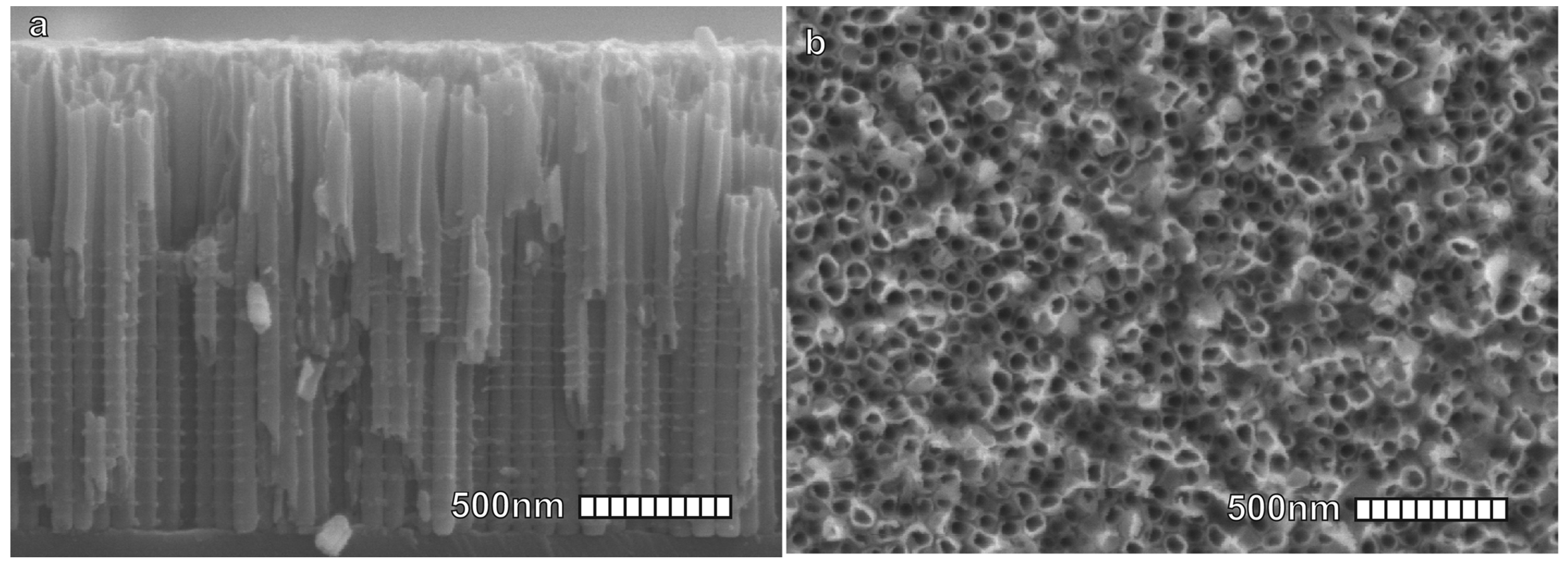
3.2. ZnO
3.3. SnO
3.4. Quantum Dots Sensitizing Techniques
- Bar coating.
- Zone casting.
- Spin coating.
- Drop coating.
- Spray coating.
- Dip coating.
- Langmuir–Blodgett.
3.4.1. Spray Coating
- 0.4 s QD monolayer spraying.
- 3 s pause.
- 1 s mercaptopropionic acid-spraying.
- 4 s methanol spraying.
- 40 s air blade drying.
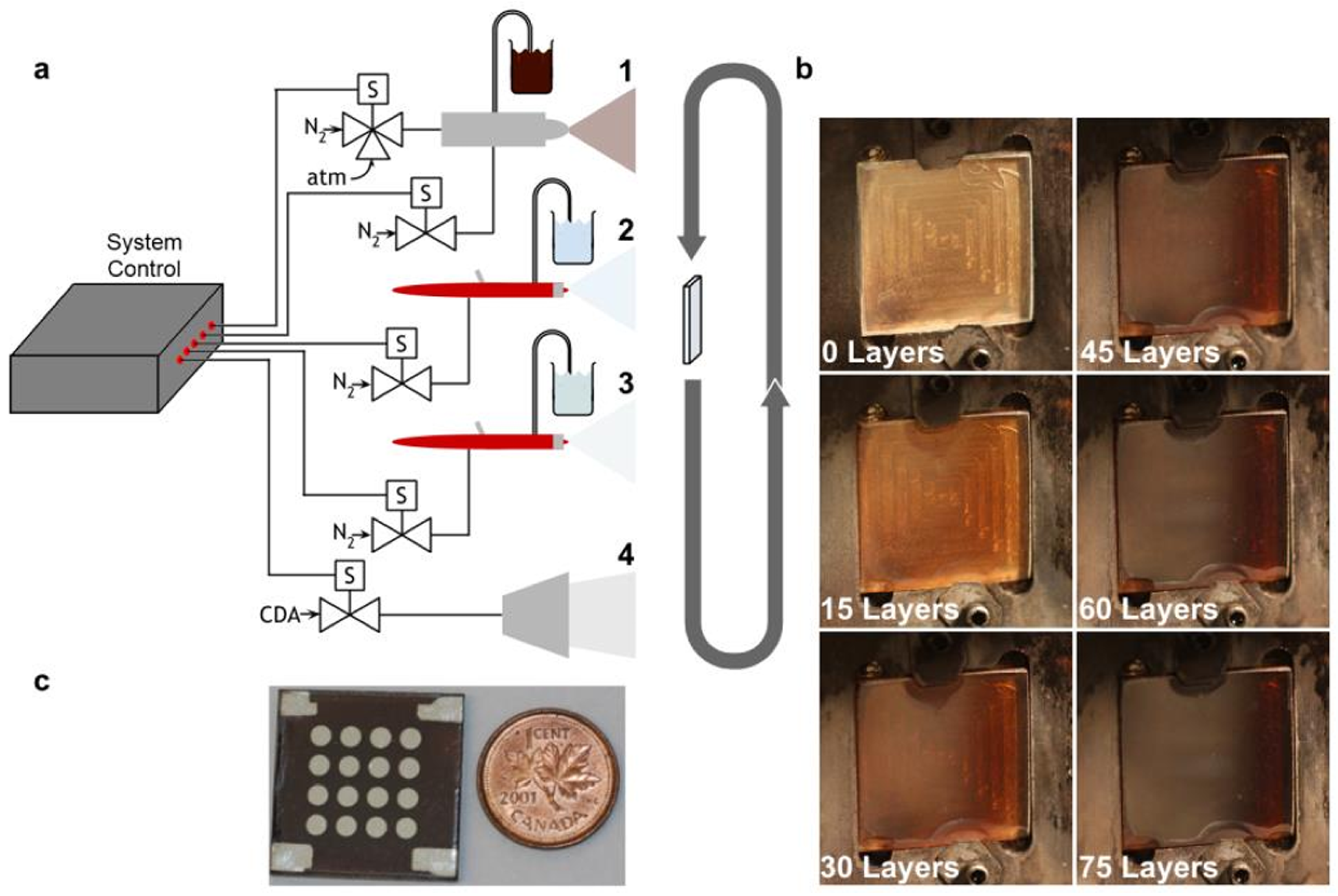
3.4.2. Dip Coating/Langmuir–Blodgett Deposition
3.5. Electronic Transport Properties of Surface-Functionalized Nanowires
4. Nanowires–Quantum Dot Solar Cells
| Fabrication Technique | Reference | J | V | PCE |
|---|---|---|---|---|
| Type of PQDs | Year | [mA/cm] | [V] | [%] |
| Spin coating | [123] | 23.4 | 1.15 | 18.3/21.5 * |
| [2019] | ||||
| Spin coating | [124] | 23.86 | 1.11 | 18.4/19.5 * |
| [2019] | ||||
| Spin coating | [125] | 23.4 | 1.14 | 19.5/21.1 * |
| [2019] | ||||
| Spin coating | [126] | 23.8 | 1.07 | 18.2/20.06 * |
| [2020] |
5. Conclusions and Outlook
- A detailed analysis of charge mobility in nanowire bodies after surface functionalization with QDs. In the literature, very short nanowire lengths had a negative impact on the overall performance of NWQDSCs, contrary to what was theoretically expected.
- In-depth research on band gap engineering due to piezo-phototronic effects at the interface between NWs and QDs, with positive effects on solar cell efficiency.
- The use of photoanodes with embedded quantum dots, as discussed in Section 2.3, has never been attempted because of the expensive physical deposition techniques needed to realize them, but scientific interest remains open.
- Finally, one overlooked aspect is the combination of nanowires with PQDs, which has proven to be much more stable than the highly performing layered versions.
Author Contributions
Funding
Acknowledgments
Conflicts of Interest
Abbreviations
| QDs | quantum dots |
| NWs | nanowires |
| VANWs | vertically aligned nanowires |
| PCE | power conversion efficiency |
| NWQDSCs | nanowires–quantum dot solar cells |
References
- Bawendi, M.G.; Steigerwald, M.L.; Brus, L.E. The Quantum Mechanics of Larger Semiconductor Clusters (“Quantum Dots”). Annu. Rev. Phys. Chem. 1990, 41, 477–496. [Google Scholar] [CrossRef]
- Farzin, M.A.; Abdoos, H. A critical review on quantum dots: From synthesis toward applications in electrochemical biosensors for determination of disease-related biomolecules. Talanta 2021, 224, 121828. [Google Scholar] [CrossRef]
- Asada, M.; Miyamoto, Y.; Suematsu, Y. Gain and the threshold of three-dimensional quantum-box lasers. IEEE J. Quantum Electron. 1986, 22, 1915–1921. [Google Scholar] [CrossRef]
- Barettin, D.; Shtrom, I.V.; Reznik, R.R.; Mikushev, S.V.; Cirlin, G.E.; Auf der Maur, M.; Akopian, N. Direct Band Gap AlGaAs Wurtzite Nanowires. Nano Lett. 2023, 23, 895–901. [Google Scholar] [CrossRef] [PubMed]
- Magna, G.; Catini, A.; Kumar, R.; Palmacci, M.; Martinelli, E.; Paolesse, R.; di Natale, C. Conductive Photo-Activated Porphyrin-ZnO Nanostructured Gas Sensor Array. Sensors 2017, 17, 747. [Google Scholar] [CrossRef] [PubMed] [Green Version]
- Li, L.; Gu, L.; Lou, Z.; Fan, Z.; Shen, G. ZnO Quantum Dot Decorated Zn2SnO4 Nanowire Heterojunction Photodetectors with Drastic Performance Enhancement and Flexible Ultraviolet Image Sensors. ACS Nano 2017, 11, 4067–4076. [Google Scholar] [CrossRef]
- Li, H.; Xu, P.; Liu, D.; He, J.; Zu, H.; Song, J.; Zhang, J.; Tian, F.; Yun, M.; Wang, F. Low-voltage and fast-response SnO2 nanotubes/perovskite heterostructure photodetector. Nanotechnology 2021, 32, 375202. [Google Scholar] [CrossRef]
- Sandhu, A. Wired for efficiency. Nat. Nanotechnol. 2009. [Google Scholar] [CrossRef]
- Leschkies, K.S.; Jacobs, A.G.; Norris, D.J.; Aydil, E.S. Nanowire-quantum-dot solar cells and the influence of nanowire length on the charge collection efficiency. Appl. Phys. Lett. 2009, 95, 193103. [Google Scholar] [CrossRef]
- Leschkies, K.S.; Beatty, T.J.; Kang, M.S.; Norris, D.J.; Aydil, E.S. Solar Cells Based on Junctions between Colloidal PbSe Nanocrystals and Thin ZnO Films. ACS Nano 2009, 3, 3638–3648. [Google Scholar] [CrossRef]
- Jean, J.; Chang, S.; Brown, P.R.; Cheng, J.J.; Rekemeyer, P.H.; Bawendi, M.G.; Gradečak, S.; Bulović, V. ZnO Nanowire Arrays for Enhanced Photocurrent in PbS Quantum Dot Solar Cells. Adv. Mater. 2013, 25, 2790–2796. [Google Scholar] [CrossRef] [PubMed]
- Wang, H.; Desbordes, M.; Xiao, Y.; Kubo, T.; Tada, K.; Bessho, T.; Nakazaki, J.; Segawa, H. Highly Stable Interdigitated PbS Quantum Dot and ZnO Nanowire Solar Cells with an Automatically Embedded Electron-Blocking Layer. ACS Appl. Energy Mater. 2021, 4, 5918–5926. [Google Scholar] [CrossRef]
- Wang, H.; Kubo, T.; Nakazaki, J.; Kinoshita, T.; Segawa, H. PbS-Quantum-Dot-Based Heterojunction Solar Cells Utilizing ZnO Nanowires for High External Quantum Efficiency in the Near-Infrared Region. J. Phys. Chem. Lett. 2013, 4, 2455–2460. [Google Scholar] [CrossRef]
- Büttner, P.; Döhler, D.; Korenko, S.; Möhrlein, S.; Bochmann, S.; Vogel, N.; Mínguez-Bacho, I.; Bachmann, J. Solid state interdigitated Sb2S3 based TiO2 nanotube solar cells. RSC Adv. 2020, 10, 28225–28231. [Google Scholar] [CrossRef] [PubMed]
- Kuo, K.T.; Liu, D.M.; Chen, S.Y.; Lin, C.C. Core-shell CuInS2/ZnS quantum dots assembled on short ZnO nanowires with enhanced photo-conversion efficiency. J. Mater. Chem. 2009, 19, 6780–6788. [Google Scholar] [CrossRef]
- Cao, X.; Chen, P.; Guo, Y. Decoration of Textured ZnO Nanowires Array with CdTe Quantum Dots: Enhanced Light-Trapping Effect and Photogenerated Charge Separation. J. Phys. Chem. C 2008, 112, 20560–20566. [Google Scholar] [CrossRef]
- Du, Z.; Artemyev, M.; Wang, J.; Tang, J. Performance improvement strategies for quantum dot-sensitized solar cells: A review. J. Mater. Chem. A 2019, 7, 2464–2489. [Google Scholar] [CrossRef]
- Rasal, A.S.; Yadav, S.; Kashale, A.A.; Altaee, A.; Chang, J.Y. Stability of quantum dot-sensitized solar cells: A review and prospects. Nano Energy 2022, 94, 106854. [Google Scholar] [CrossRef]
- Xu, J.; Chen, Z.; Zapien, J.A.; Lee, C.S.; Zhang, W. Surface Engineering of ZnO Nanostructures for Semiconductor-Sensitized Solar Cells. Adv. Mater. 2014, 26, 5337–5367. [Google Scholar] [CrossRef]
- Consonni, V.; Briscoe, J.; Kärber, E.; Li, X.; Cossuet, T. ZnO nanowires for solar cells: A comprehensive review. Nanotechnology 2019, 30, 362001. [Google Scholar] [CrossRef]
- Skompska, M.; Zarȩbska, K. Electrodeposition of ZnO Nanorod Arrays on Transparent Conducting Substrates—A Review. Electrochim. Acta 2014, 127, 467–488. [Google Scholar] [CrossRef]
- Sharma, K.; Sharma, V.; Sharma, S.S. Dye-Sensitized Solar Cells: Fundamentals and Current Status. Nanoscale Res. Lett. 2018, 13, 381. [Google Scholar] [CrossRef] [PubMed]
- Ren, Y.; Zhang, D.; Suo, J.; Cao, Y.; Eickemeyer, F.T.; Vlachopoulos, N.; Zakeeruddin, S.M.; Hagfeldt, A.; Grätzel, M. Hydroxamic acid pre-adsorption raises the efficiency of cosensitized solar cells. Nature 2023, 613, 60–65. [Google Scholar] [CrossRef]
- The Business Research Company. Quantum Dot Global Market Report 2023; Technical Report; The Business Research Company: London, UK, 2023. [Google Scholar]
- Jo, J.H.; Jo, D.Y.; Lee, S.H.; Yoon, S.Y.; Lim, H.B.; Lee, B.J.; Do, Y.R.; Yang, H. InP-Based Quantum Dots Having an InP Core, Composition-Gradient ZnSeS Inner Shell, and ZnS Outer Shell with Sharp, Bright Emissivity, and Blue Absorptivity for Display Devices. ACS Appl. Nano Mater. 2020, 3, 1972–1980. [Google Scholar] [CrossRef]
- Montalti, M.; Cantelli, A.; Battistelli, G. Nanodiamonds and silicon quantum dots: Ultrastable and biocompatible luminescent nanoprobes for long-term bioimaging. Chem. Soc. Rev. 2015, 44, 4853–4921. [Google Scholar] [CrossRef] [PubMed]
- Kim, T.; Kim, K.H.; Kim, S.; Choi, S.M.; Jang, H.; Seo, H.K.; Lee, H.; Chung, D.Y.; Jang, E. Efficient and stable blue quantum dot light-emitting diode. Nature 2020, 586, 385–389. [Google Scholar] [CrossRef]
- Wu, X.G.; Ji, H.; Yan, X.; Zhong, H. Industry outlook of perovskite quantum dots for display applications. Nat. Nanotechnol. 2022, 17, 813–816. [Google Scholar] [CrossRef]
- Arachchige, I.U.; Brock, S.L. Sol–Gel Methods for the Assembly of Metal Chalcogenide Quantum Dots. Acc. Chem. Res. 2007, 40, 801–809. [Google Scholar] [CrossRef]
- Bera, D.; Qian, L.; Sabui, S.; Santra, S.; Holloway, P.H. Photoluminescence of ZnO quantum dots produced by a sol–gel process. Opt. Mater. 2008, 30, 1233–1239. [Google Scholar] [CrossRef]
- Jiang, H.; Yao, X.; Che, J.; Wang, M.; Kong, F. Preparation of ZnSe quantum dots embedded in SiO2 thin films by sol–gel process. Ceram. Int. 2004, 30, 1685–1689. [Google Scholar] [CrossRef]
- Lin, K.F.; Cheng, H.M.; Hsu, H.C.; Lin, L.J.; Hsieh, W.F. Band gap variation of size-controlled ZnO quantum dots synthesized by sol–gel method. Chem. Phys. Lett. 2005, 409, 208–211. [Google Scholar] [CrossRef]
- Chen, X.; Wang, Q.; Wang, X.J.; Li, J.; Xu, G.B. Synthesis and performance of ZnO quantum dots water-based fluorescent ink for anti-counterfeiting applications. Sci. Rep. 2021, 11, 5841. [Google Scholar] [CrossRef]
- Raffaelle, R.P.; Castro, S.L.; Hepp, A.F.; Bailey, S.G. Quantum dot solar cells. Prog. Photovolt. Res. Appl. 2002, 10, 433–439. [Google Scholar] [CrossRef]
- Liu, X.; Lin, Y.; Chen, Y.; An, L.; Ji, X.; Jiang, B. New Organometallic Approach to Synthesize High-quality CdSe Quantum Dots. Chem. Lett. 2005, 34, 1284–1285. [Google Scholar] [CrossRef]
- Pu, Y.; Cai, F.; Wang, D.; Wang, J.X.; Chen, J.F. Colloidal Synthesis of Semiconductor Quantum Dots toward Large-Scale Production: A Review. Ind. Eng. Chem. Res. 2018, 57, 1790–1802. [Google Scholar] [CrossRef]
- Matsumoto, T.; Maenosono, S.; Yamaguchi, Y. Organometallic Synthesis of InP Quantum Dots Using Tris(dimethylamino)phosphine as a Phosphorus Source. Chem. Lett. 2004, 33, 1492–1493. [Google Scholar] [CrossRef]
- Wolska-Pietkiewicz, M.; Tokarska, K.; Grala, A.; Wojewódzka, A.; Chwojnowska, E.; Grzonka, J.; Cywiński, P.J.; Kruczała, K.; Sojka, Z.; Chudy, M.; et al. Safe-by-Design Ligand-Coated ZnO Nanocrystals Engineered by an Organometallic Approach: Unique Physicochemical Properties and Low Toxicity toward Lung Cells. Chem. Eur. J. 2018, 24, 4033–4042. [Google Scholar] [CrossRef]
- Francaviglia, L.; Fontana, Y.; Fontcuberta i Morral, A. Chapter Five—Quantum Dots in Nanowires. In Semiconductor Nanowires II: Properties and Applications; Semiconductors and Semimetals; Dayeh, S.A., Fontcuberta i Morral, A., Jagadish, C., Eds.; Elsevier: Amsterdam, The Netherlands, 2016; Volume 94, pp. 159–184. [Google Scholar] [CrossRef]
- So, H.; Pan, D.; Li, L.; Zhao, J. Foreign-catalyst-free growth of InAs/InSb axial heterostructure nanowires on Si (111) by molecular-beam epitaxy. Nanotechnology 2017, 28, 135704. [Google Scholar] [CrossRef]
- Kang, S.; Ryu, J.H.; Lee, B.; Jung, K.H.; Shim, K.B.; Han, H.; Kim, K.M. Laser wavelength modulated pulsed laser ablation for selective and efficient production of graphene quantum dots. RSC Adv. 2019, 9, 13658–13663. [Google Scholar] [CrossRef] [PubMed] [Green Version]
- Zhang, T.; Fu, L. Controllable Chemical Vapor Deposition Growth of Two-Dimensional Heterostructures. Chem 2018, 4, 671–689. [Google Scholar] [CrossRef] [Green Version]
- Haapamaki, C.M.; LaPierre, R.R. Mechanisms of molecular beam epitaxy growth in InAs/InP nanowire heterostructures. Nanotechnology 2011, 22, 335602. [Google Scholar] [CrossRef]
- Eisenhawer, B.; Sivakov, V.; Berger, A.; Christiansen, S. Growth of axial SiGe heterostructures in nanowires using pulsed laser deposition. Nanotechnology 2011, 22, 305604. [Google Scholar] [CrossRef] [PubMed] [Green Version]
- Mermillod, Q.; Wigger, D.; Delmonte, V.; Reiter, D.E.; Schneider, C.; Kamp, M.; Höfling, S.; Langbein, W.; Kuhn, T.; Nogues, G.; et al. Dynamics of excitons in individual InAs quantum dots revealed in four-wave mixing spectroscopy. Optica 2016, 3, 377–384. [Google Scholar] [CrossRef] [Green Version]
- Uccelli, E.; Arbiol, J.; Morante, J.R.; Fontcuberta i Morral, A. InAs Quantum Dot Arrays Decorating the Facets of GaAs Nanowires. ACS Nano 2010, 4, 5985–5993. [Google Scholar] [CrossRef] [PubMed]
- Barettin, D.; Pecchia, A.; Auf der Maur, M.; Di Carlo, A.; Lassen, B.; Willatzen, M. Electromechanical field effects in InAs/GaAs quantum dots based on continuum k→·p→ and atomistic tight-binding methods. Comput. Mater. Sci. 2021, 197, 110678. [Google Scholar] [CrossRef]
- Sedky, S.; Witvrouw, A.; Bender, H.; Baert, K. Experimental determination of the maximum post-process annealing temperature for standard CMOS wafers. IEEE Trans. Electron Devices 2001, 48, 377–385. [Google Scholar] [CrossRef]
- Barettin, D.; Sakharov, A.V.; Tsatsulnikov, A.F.; Nikolaev, A.E.; Pecchia, A.; Auf der Maur, M.; Karpov, S.Y.; Cherkashin, N. Impact of Local Composition on the Emission Spectra of InGaN Quantum-Dot LEDs. Nanomaterials 2023, 13, 1367. [Google Scholar] [CrossRef]
- Park, S.; Cho, E.; Song, D.; Conibeer, G.; Green, M.A. n-Type silicon quantum dots and p-type crystalline silicon heteroface solar cells. Sol. Energy Mater. Sol. Cells 2009, 93, 684–690. [Google Scholar] [CrossRef]
- Blanton, S.A.; Leheny, R.L.; Hines, M.A.; Guyot-Sionnest, P. Dielectric Dispersion Measurements of CdSe Nanocrystal Colloids: Observation of a Permanent Dipole Moment. Phys. Rev. Lett. 1997, 79, 865–868. [Google Scholar] [CrossRef]
- Park, Y.M.; Park, Y.J.; Song, J.D.; Lee, J.I. Estimation of built-in dipole moment in InAs quantum dots. Solid State Commun. 2005, 134, 391–395. [Google Scholar] [CrossRef]
- Jayah, N.A.; Yahaya, H.; Mahmood, M.R.; Terasako, T.; Yasui, K.; Hashim, A.M. High electron mobility and low carrier concentration of hydrothermally grown ZnO thin films on seeded a-plane sapphire at low temperature. Nanoscale Res. Lett. 2015, 10, 7. [Google Scholar] [CrossRef] [PubMed] [Green Version]
- Lv, L.; Lu, Q.; Ning, Y.; Lu, Z.; Wang, X.; Lou, Z.; Tang, A.; Hu, Y.; Teng, F.; Yin, Y.; et al. Self-Assembled TiO2 Nanorods as Electron Extraction Layer for High-Performance Inverted Polymer Solar Cells. Chem. Mater. 2015, 27, 44–52. [Google Scholar] [CrossRef] [Green Version]
- Zhan, P.; Chen, J.; Chen, L. Influence of SnO2, ZnO and TiO2 layer on the performance of CIGS and CdTe solar cells. Iop Conf. Ser. Earth Environ. Sci. 2021, 781, 042069. [Google Scholar] [CrossRef]
- Nguyen, N.V.; Nguyen, N.; Hattrick-Simpers, J.R.; Kirillov, O.A.; Green, M.L. Optical spectra and interfacial band offsets of pulse-laser-deposited metal-oxides: SnO2, TiO2, and ZnO. Appl. Phys. Lett. 2021, 118. [Google Scholar] [CrossRef]
- Wehrenfennig, C.; Palumbiny, C.M.; Snaith, H.J.; Johnston, M.B.; Schmidt-Mende, L.; Herz, L.M. Fast Charge-Carrier Trapping in TiO2 Nanotubes. J. Phys. Chem. C 2015, 119, 9159–9168. [Google Scholar] [CrossRef]
- Gubbala, S.; Chakrapani, V.; Kumar, V.; Sunkara, M.K. Band-edge engineered hybrid structures for dye-sensitized solar cells based on SnO2 nanowires. Adv. Funct. Mater. 2008, 18, 2411–2418. [Google Scholar] [CrossRef]
- Dunn, H.K.; Peter, L.M. How Efficient Is Electron Collection in Dye-Sensitized Solar Cells? Comparison of Different Dynamic Methods for the Determination of the Electron Diffusion Length. J. Phys. Chem. C 2009, 113, 4726–4731. [Google Scholar] [CrossRef]
- Gong, D.; Grimes, C.A.; Varghese, O.K.; Hu, W.; Singh, R.S.; Chen, Z.; Dickey, E.C. Titanium oxide nanotube arrays prepared by anodic oxidation. J. Mater. Res. 2001, 16, 3331–3334. [Google Scholar] [CrossRef] [Green Version]
- Wang, H.E.; Chen, Z.; Leung, Y.H.; Luan, C.; Liu, C.; Tang, Y.; Yan, C.; Zhang, W.; Zapien, J.A.; Bello, I.; et al. Hydrothermal synthesis of ordered single-crystalline rutile TiO2 nanorod arrays on different substrates. Appl. Phys. Lett. 2010, 96, 263104. [Google Scholar] [CrossRef]
- Roy, P.; Berger, S.; Schmuki, P. TiO2 Nanotubes: Synthesis and Applications. Angew. Chem. Int. Ed. 2011, 50, 2904–2939. [Google Scholar] [CrossRef]
- Lan, X.; Bai, J.; Masala, S.; Thon, S.M.; Ren, Y.; Kramer, I.J.; Hoogland, S.; Simchi, A.; Koleilat, G.I.; Paz-Soldan, D.; et al. Self-Assembled, Nanowire Network Electrodes for Depleted Bulk Heterojunction Solar Cells (Adv. Mater. 12/2013). Adv. Mater. 2013, 25, 1768. [Google Scholar] [CrossRef]
- Han, H.; Sudhagar, P.; Song, T.; Jeon, Y.; Mora-Seró, I.; Fabregat-Santiago, F.; Bisquert, J.; Kang, Y.S.; Paik, U. Three dimensional-TiO2 nanotube array photoanode architectures assembled on a thin hollow nanofibrous backbone and their performance in quantum dot-sensitized solar cells. Chem. Commun. 2013, 49, 2810–2812. [Google Scholar] [CrossRef] [PubMed]
- Briscoe, J.; Shoaee, S.; Durrant, J.R.; Dunn, S. Piezoelectric Enhancement of Hybrid Organic/Inorganic Photovoltaic Device. J. Phys. Conf. Ser. 2013, 476, 012009. [Google Scholar] [CrossRef] [Green Version]
- Zhu, L.; Wang, Z.L. Recent Progress in Piezo-Phototronic Effect Enhanced Solar Cells. Adv. Funct. Mater. 2019, 29, 1808214. [Google Scholar] [CrossRef]
- Zheng, Z.; Lim, Z.S.; Peng, Y.; You, L.; Chen, L.; Wang, J. General route to ZnO nanorod arrays on conducting substrates via galvanic-cell-based approach. Sci. Rep. 2013, 3, 2434. [Google Scholar] [CrossRef] [Green Version]
- Orsini, A.; Medaglia, P.G.; Scarpellini, D.; Pizzoferrato, R.; Falconi, C. Towards high-performance, low-cost quartz sensors with high-density, well-separated, vertically aligned ZnO nanowires by low-temperature, seed-less, single-step, double-sided growth. Nanotechnology 2013, 24, 355503. [Google Scholar] [CrossRef]
- Arrabito, G.; Errico, V.; Zhang, Z.; Han, W.; Falconi, C. Nanotransducers on printed circuit boards by rational design of high-density, long, thin and untapered ZnO nanowires. Nano Energy 2018, 46, 54–62. [Google Scholar] [CrossRef]
- Orsini, A.; Falconi, C. Real-time monitoring of the solution growth of ZnO nanorods arrays by quartz microbalances and in-situ temperature sensors. Sci. Rep. 2014, 4, 6285. [Google Scholar] [CrossRef] [Green Version]
- Chakraborty, A.; Orsini, A.; Kar, J.P.; Gatta, F.; Khan, U.; Falconi, C. Ultra-efficient thermo-convective solution-growth of vertically aligned ZnO nanowires. Nano Energy 2022, 97, 107167. [Google Scholar] [CrossRef]
- Zhu, G.; Zhou, Y.; Wang, S.; Yang, R.; Ding, Y.; Wang, X.; Bando, Y.; Wang, Z.L. Synthesis of vertically aligned ultra-long ZnO nanowires on heterogeneous substrates with catalyst at the root. Nanotechnology 2012, 23, 055604. [Google Scholar] [CrossRef]
- Cheng, J.J.; Chuang, C.H.M.; Hentz, O.; Rekemeyer, P.H.; Bawendi, M.G.; Gradečak, S. Dimension- and Surface-Tailored ZnO Nanowires Enhance Charge Collection in Quantum Dot Photovoltaic Devices. ACS Appl. Energy Mater. 2018, 1, 1815–1822. [Google Scholar] [CrossRef]
- Tien, L.C.; Pearton, S.J.; Norton, D.P.; Ren, F. Synthesis and characterization of single crystalline SnO2 nanorods by high-pressure pulsed laser deposition. Appl. Phys. A Mater. Sci. Process. 2008, 91, 29–32. [Google Scholar] [CrossRef]
- Mazeina, L.; Picard, Y.N.; Caldwell, J.D.; Glaser, E.R.; Prokes, S.M. Growth and photoluminescence properties of vertically aligned SnO2 nanowires. J. Cryst. Growth 2009, 311, 3158–3162. [Google Scholar] [CrossRef]
- Zhou, Z.; Wu, J.; Li, H.; Wang, Z. Field emission from in situ-grown vertically aligned SnO2 nanowire arrays. Nanoscale Res. Lett. 2012, 7, 117. [Google Scholar] [CrossRef] [PubMed] [Green Version]
- Zhu, W.; Wang, W.; Xu, H.; Shi, J. Fabrication of ordered SnO2 nanotube arrays via a template route. Mater. Chem. Phys. 2006, 99, 127–130. [Google Scholar] [CrossRef]
- Lupan, O.; Chow, L.; Chai, G.; Heinrich, H.H.; Park, S.; Schulte, A. Synthesis of one-dimensional SnO2 nanorods via a hydrothermal technique. Phys. E-Low Syst. Nanostruct. 2009, 41, 533–536. [Google Scholar] [CrossRef]
- Han, X.; Han, X.; Sun, L.; Liu, Q.; Wei, X.; Li, L.; Wang, P.; Wang, C. One-step synthesis of highly aligned SnO2 nanorods on a self-produced Na2Sn(OH)6 substrate for high-performance lithium-ion batteries. CrystEngComm 2015, 17, 1754–1757. [Google Scholar] [CrossRef]
- Bera, S.; Lee, S.A.; Kim, C.M.; Khan, H.; Jang, H.W.; Kwon, S.H. Controlled Synthesis of Vertically Aligned SnO2 Nanograss-Structured Thin Films for SnO2/BiVO4 Core–Shell Heterostructures with Highly Enhanced Photoelectrochemical Properties. Chem. Mater. 2018, 30, 8501–8509. [Google Scholar] [CrossRef]
- Lu, Z.; Wang, C.; Deng, W.; Achille, M.T.; Jie, J.; Zhang, X. Meniscus-guided coating of organic crystalline thin films for high-performance organic field-effect transistors. J. Mater. Chem. C 2020, 8, 9133–9146. [Google Scholar] [CrossRef]
- Susanna, G.; Salamandra, L.; Brown, T.M.; Di Carlo, A.; Brunetti, F.; Reale, A. Airbrush spray-coating of polymer bulk-heterojunction solar cells. Sol. Energy Mater. Sol. Cells 2011, 95, 1775–1778. [Google Scholar] [CrossRef]
- Wang, T.; Scarratt, N.W.; Yi, H.; Dunbar, A.D.F.; Pearson, A.J.; Watters, D.C.; Glen, T.S.; Brook, A.C.; Kingsley, J.; Buckley, A.R.; et al. Fabricating High Performance, Donor–Acceptor Copolymer Solar Cells by Spray-Coating in Air. Adv. Energy Mater. 2013, 3, 505–512. [Google Scholar] [CrossRef]
- Kramer, I.J.; Minor, J.C.; Moreno-Bautista, G.; Rollny, L.; Kanjanaboos, P.; Kopilovic, D.; Thon, S.M.; Carey, G.H.; Chou, K.W.; Zhitomirsky, D.; et al. Efficient Spray-Coated Colloidal Quantum Dot Solar Cells. Adv. Mater. 2015, 27, 116–121. [Google Scholar] [CrossRef] [PubMed] [Green Version]
- Lambert, K.; Moreels, I.; Thourhout, D.V.; Hens, Z. Quantum Dot Micropatterning on Si. Langmuir 2008, 24, 5961–5966. [Google Scholar] [CrossRef] [PubMed]
- Lambert, K.; Wittebrood, L.; Moreels, I.; Deresmes, D.; Grandidier, B.; Hens, Z. Langmuir–Blodgett monolayers of InP quantum dots with short chain ligands. J. Colloid Interface Sci. 2006, 300, 597–602. [Google Scholar] [CrossRef] [PubMed]
- Méthivier, C.; Busson, B. Semiconductor quantum dots reveal dipolar coupling from exciton to ligand vibration. Commun. Chem. 2018, 1, 76. [Google Scholar] [CrossRef] [Green Version]
- Schnitzenbaumer, K.J.; Dukovic, G. Comparison of Phonon Damping Behavior in Quantum Dots Capped with Organic and Inorganic Ligands. Nano Lett. 2018, 18, 3667–3674. [Google Scholar] [CrossRef]
- Chang, S.J.; Hsueh, T.J.; Hsu, C.L.; Lin, Y.R.; Chen, I.C.; Huang, B.R. A ZnO nanowire vacuum pressure sensor. Nanotechnology 2008, 19, 095505. [Google Scholar] [CrossRef]
- Wu, L.; Song, F.; Fang, X.; Guo, Z.X.; Liang, S. A practical vacuum sensor based on a ZnO nanowire array. Nanotechnology 2010, 21, 475502. [Google Scholar] [CrossRef]
- Zheng, X.J.; Cao, X.C.; Sun, J.; Yuan, B.; Li, Q.H.; Zhu, Z.; Zhang, Y. A vacuum pressure sensor based on ZnO nanobelt film. Nanotechnology 2011, 22, 435501. [Google Scholar] [CrossRef]
- Han, N.; Wang, F.; Hou, J.J.; Yip, S.P.; Lin, H.; Xiu, F.; Fang, M.; Yang, Z.; Shi, X.; Dong, G.; et al. Tunable Electronic Transport Properties of Metal-Cluster-Decorated III–V Nanowire Transistors. Adv. Mater. 2013, 25, 4445–4451. [Google Scholar] [CrossRef]
- Lee, E.; Park, J.; Yim, M.; Jeong, S.; Yoon, G. High-efficiency micro-energy generation based on free-carrier-modulated ZnO:N piezoelectric thin films. Appl. Phys. Lett. 2014, 104, 213908. [Google Scholar] [CrossRef]
- Chakraborty, A.; Agresti, A.; Pizzoferrato, R.; Matteis, F.D.; Orsini, A.; Medaglia, P.G. Study of structural and optical properties of low temperature photo-activated ZnO-rGO composite thin film. Mater. Res. Bull. 2017, 91, 227–231. [Google Scholar] [CrossRef]
- Sivalingam, Y.; Magna, G.; Pomarico, G.; Catini, A.; Martinelli, E.; Paolesse, R.; Di Natale, C. The influence of gas adsorption on photovoltage in porphyrin coated ZnO nanorods. J. Mater. Chem. 2012, 22, 20032–20037. [Google Scholar] [CrossRef]
- Xing, M.; Wang, L.; Wang, R. A review on the effects of zno nanowire morphology on the performance of interpenetrating bulk heterojunction quantum dot solar cells. Nanomaterials 2022, 12, 114. [Google Scholar] [CrossRef] [PubMed]
- Mora-Seró, I. Current Challenges in the Development of Quantum Dot Sensitized Solar Cells. Adv. Energy Mater. 2020, 10, 2001774. [Google Scholar] [CrossRef]
- Liu, Z.; Huang, J.; Han, J.; Hong, T.; Zhang, J.; Liu, Z. CuSbS2: A promising semiconductor photo-absorber material for quantum dot sensitized solar cells. Phys. Chem. Chem. Phys. 2016, 18, 16615–16620. [Google Scholar] [CrossRef] [PubMed]
- Zhao, H.; Huang, F.; Hou, J.; Liu, Z.; Wu, Q.; Cao, H.; Jing, Q.; Peng, S.; Cao, G. Efficiency Enhancement of Quantum Dot Sensitized TiO2/ZnO Nanorod Arrays Solar Cells by Plasmonic Ag Nanoparticles. ACS Appl. Mater. Interfaces 2016, 8, 26675–26682. [Google Scholar] [CrossRef]
- Rekemeyer, P.H.; Chang, S.; Chuang, C.H.M.; Hwang, G.W.; Bawendi, M.G.; Gradečak, S. Enhanced Photocurrent in PbS Quantum Dot Photovoltaics via ZnO Nanowires and Band Alignment Engineering. Adv. Energy Mater. 2016, 6, 1600848. [Google Scholar] [CrossRef]
- Wang, W.; Jiang, G.; Yu, J.; Wang, W.; Pan, Z.; Nakazawa, N.; Shen, Q.; Zhong, X. High Efficiency Quantum Dot Sensitized Solar Cells Based on Direct Adsorption of Quantum Dots on Photoanodes. ACS Appl. Mater. Interfaces 2017, 9, 22549–22559. [Google Scholar] [CrossRef]
- Chiang, Y.H.; Lin, K.Y.; Chen, Y.H.; Waki, K.; Abate, M.A.; Jiang, J.C.; Chang, J.Y. Aqueous solution-processed off-stoichiometric Cu–In–S QDs and their application in quantum dot-sensitized solar cells. J. Mater. Chem. A 2018, 6, 9629–9641. [Google Scholar] [CrossRef]
- Ozu, S.; Zhang, Y.; Yasuda, H.; Kitabatake, Y.; Toyoda, T.; Hirata, M.; Yoshino, K.; Katayama, K.; Hayase, S.; Wang, R.; et al. Improving photovoltaic performance of ZnO nanowires based colloidal quantum dot solar cells via SnO2 passivation strategy. Front. Energy Res. 2019, 7, 11. [Google Scholar] [CrossRef]
- Shi, G.; Kaewprajak, A.; Ling, X.; Hayakawa, A.; Zhou, S.; Song, B.; Kang, Y.; Hayashi, T.; Altun, M.E.; Nakaya, M.; et al. Finely Interpenetrating Bulk Heterojunction Structure for Lead Sulfide Colloidal Quantum Dot Solar Cells by Convective Assembly. ACS Energy Lett. 2019, 4, 960–967. [Google Scholar] [CrossRef]
- Tavakoli Dastjerdi, H.; Prochowic, D.; Yadav, P.; Tavakoli, M.M. Luminescence down-shifting enables UV-stable and efficient ZnO nanowire-based PbS quantum dot solar cells with JSC exceeding 33 mA/cm2. Sustain. Energy Fuels 2019, 3, 3128–3134. [Google Scholar] [CrossRef]
- Tavakoli Dastjerdi, H.; Prochowicz, D.; Yadav, P.; Tavakoli, M.M. Tuning Areal Density and Surface Passivation of ZnO Nanowire Array Enable Efficient PbS QDs Solar Cells with Enhanced Current Density. Adv. Mater. Interfaces 2020, 7, 1901551. [Google Scholar] [CrossRef]
- Rao, H.; Zhou, M.; Pan, Z.; Zhong, X. Quantum dot materials engineering boosting the quantum dot sensitized solar cell efficiency over 13%. J. Mater. Chem. A 2020, 8, 10233–10241. [Google Scholar] [CrossRef]
- Song, H.; Lin, Y.; Zhang, Z.; Rao, H.; Wang, W.; Fang, Y.; Pan, Z.; Zhong, X. Improving the Efficiency of Quantum Dot Sensitized Solar Cells beyond 15% via Secondary Deposition. J. Am. Chem. Soc. 2021, 143, 4790–4800. [Google Scholar] [CrossRef]
- Wang, Y.; Zhong, M.; Wang, W.; Wang, Q.; Wu, W.; Luo, X. Effects of ZnSe modification on the perovskite films and perovskite solar cells based on ZnO nanorod arrays. Appl. Surf. Sci. 2019, 495, 143552. [Google Scholar] [CrossRef]
- Xiong, J.; You, Z.; Lei, S.; Zhao, K.; Bian, Q.; Xiao, Y.; Cheng, B. Solution Growth of BiSI Nanorod Arrays on a Tungsten Substrate for Solar Cell Application. ACS Sustain. Chem. Eng. 2020, 8, 13488–13496. [Google Scholar] [CrossRef]
- Solís-Cortés, D.; Jiménez, F.M.; Jauregui, G.; Gau, D.; Pereyra, J.; Henríquez, R.; Marotti, R.E.; Ramos-Barrado, J.R.; Dalchiele, E.A. Optimization of Ag2S Quantum Dots Decorated ZnO Nanorod Array Photoanodes for Enhanced Photoelectrochemical Performances. J. Electrochem. Soc. 2021, 168, 56516. [Google Scholar] [CrossRef]
- Mahmood, K.; Swain, B.S.; Amassian, A. 16.1% Efficient Hysteresis-Free Mesostructured Perovskite Solar Cells Based on Synergistically Improved ZnO Nanorod Arrays. Adv. Energy Mater. 2015, 5, 1500568. [Google Scholar] [CrossRef]
- Tai, M.; Zhao, X.; Shen, H.; Guo, Y.; Zhang, M.; Zhou, Y.; Li, X. Ultrathin Zn2SnO4 (ZTO) passivated ZnO nanocone arrays for efficient and stable perovskite solar cells. Chem. Eng. J. 2019, 361, 60–66. [Google Scholar] [CrossRef]
- Fahim, M.; Firdous, I.; Zhang, W.; Daoud, W.A. Bifunctional interfacial engineering for piezo-phototronic enhanced photovoltaic performance of wearable perovskite solar cells. Nano Energy 2021, 86, 106127. [Google Scholar] [CrossRef]
- Chen, K.; Tang, W.; Chen, Y.; Yuan, R.; Lv, Y.; Shan, W.; Zhang, W.H. A facile solution processed ZnO@ZnS core–shell nanorods arrays for high-efficiency perovskite solar cells with boosted stability. J. Energy Chem. 2021, 61, 553–560. [Google Scholar] [CrossRef]
- Furasova, A.; Voroshilov, P.; Sapori, D.; Ladutenko, K.; Barettin, D.; Zakhidov, A.; Di Carlo, A.; Simovski, C.; Makarov, S. Nanophotonics for Perovskite Solar Cells. Adv. Photonics Res. 2022, 3, 2100326. [Google Scholar] [CrossRef]
- Xiao, Y.; Cui, X.; Xiang, B.; Chen, Y.; Zhao, C.; Wang, L.; Yang, C.; Zhang, G.; Xie, C.; Han, Y.; et al. MDACl2-Modified SnO2 Film for Efficient Planar Perovskite Solar Cells. Molecules 2023, 28, 2668. [Google Scholar] [CrossRef]
- Han, L.; Hu, H.; Yuan, M.; Lin, P.; Wang, P.; Xu, L.; Yu, X.; Cui, C. CuCl2-modified SnO2 electron transport layer for high efficiency perovskite solar cells. Nanotechnology 2023, 34, 305401. [Google Scholar] [CrossRef]
- Barettin, D.; Platonov, A.V.; Pecchia, A.; Kats, V.N.; Cirlin, G.E.; Soshnikov, I.P.; Bouravleuv, A.D.; Besombes, L.; Mariette, H.; der Maur, M.A.; et al. Model of a GaAs Quantum Dot Embedded in a Polymorph AlGaAs Nanowire. IEEE J. Sel. Top. Quantum Electron. 2013, 19, 1–9. [Google Scholar] [CrossRef] [Green Version]
- Massiot, I.; Cattoni, A.; Collin, S. Progress and prospects for ultrathin solar cells. Nat. Energy 2020, 5, 959–972. [Google Scholar] [CrossRef]
- Mencattini, A.; Orsini, A.; Falconi, C. 3D Reconstruction of Quasi-1D Single-Crystal Nanostructures. Adv. Mater. 2015, 27, 6271–6276. [Google Scholar] [CrossRef]
- Liu, L.; Najar, A.; Wang, K.; Du, M.; Liu, S.F. Perovskite Quantum Dots in Solar Cells. Adv. Sci. 2022, 9, 2104577. [Google Scholar] [CrossRef]
- Zheng, X.; Troughton, J.; Gasparini, N.; Lin, Y.; Wei, M.; Hou, Y.; Liu, J.; Song, K.; Chen, Z.; Yang, C.; et al. Quantum Dots Supply Bulk- and Surface-Passivation Agents for Efficient and Stable Perovskite Solar Cells. Joule 2019, 3, 1963–1976. [Google Scholar] [CrossRef]
- Que, M.; Dai, Z.; Yang, H.; Zhu, H.; Zong, Y.; Que, W.; Padture, N.P.; Zhou, Y.; Chen, O. Quantum-Dot-Induced Cesium-Rich Surface Imparts Enhanced Stability to Formamidinium Lead Iodide Perovskite Solar Cells. ACS Energy Lett. 2019, 4, 1970–1975. [Google Scholar] [CrossRef]
- Akin, S.; Altintas, Y.; Mutlugun, E.; Sonmezoglu, S. Cesium–lead based inorganic perovskite quantum-dots as interfacial layer for highly stable perovskite solar cells with exceeding 21% efficiency. Nano Energy 2019, 60, 557–566. [Google Scholar] [CrossRef]
- Xie, L.; Vashishtha, P.; Koh, T.M.; Harikesh, P.C.; Jamaludin, N.F.; Bruno, A.; Hooper, T.J.N.; Li, J.; Ng, Y.F.; Mhaisalkar, S.G.; et al. Realizing Reduced Imperfections via Quantum Dots Interdiffusion in High Efficiency Perovskite Solar Cells. Adv. Mater. 2020, 32, 2003296. [Google Scholar] [CrossRef]
- Kim, D.I.; Lee, J.W.; Jeong, R.H.; Boo, J.H. A high-efficiency and stable perovskite solar cell fabricated in ambient air using a polyaniline passivation layer. Sci. Rep. 2022, 12, 697. [Google Scholar] [CrossRef]
- Zhou, D.; Liu, D.; Pan, G.; Chen, X.; Li, D.; Xu, W.; Bai, X.; Song, H. Cerium and Ytterbium Codoped Halide Perovskite Quantum Dots: A Novel and Efficient Downconverter for Improving the Performance of Silicon Solar Cells. Adv. Mater. 2017, 29, 1704149. [Google Scholar] [CrossRef]
- Obraztsova, A.A.; Barettin, D.; Furasova, A.D.; Voroshilov, P.M.; Auf der Maur, M.; Orsini, A.; Makarov, S.V. Light-trapping electrode for the efficiency enhancement of bifacial perovskite solar cells. Nanomaterials 2022, 12, 3210. [Google Scholar] [CrossRef]
- Trucchi, D.; Bellucci, A.; Girolami, M.; Calvani, P.; Cappelli, E.; Orlando, S.; Polini, R.; Silvestroni, L.; Sciti, D.; Kribus, A. Solar Thermionic-Thermoelectric Generator (ST2G): Concept, Materials Engineering, and Prototype Demonstration. Adv. Energy Mater. 2018, 8, 1802310. [Google Scholar] [CrossRef]
- Yao, M.; Cong, S.; Arab, S.; Huang, N.; Povinelli, M.L.; Cronin, S.B.; Dapkus, P.D.; Zhou, C. Tandem Solar Cells Using GaAs Nanowires on Si: Design, Fabrication, and Observation of Voltage Addition. Nano Lett. 2015, 15, 7217–7224. [Google Scholar] [CrossRef]
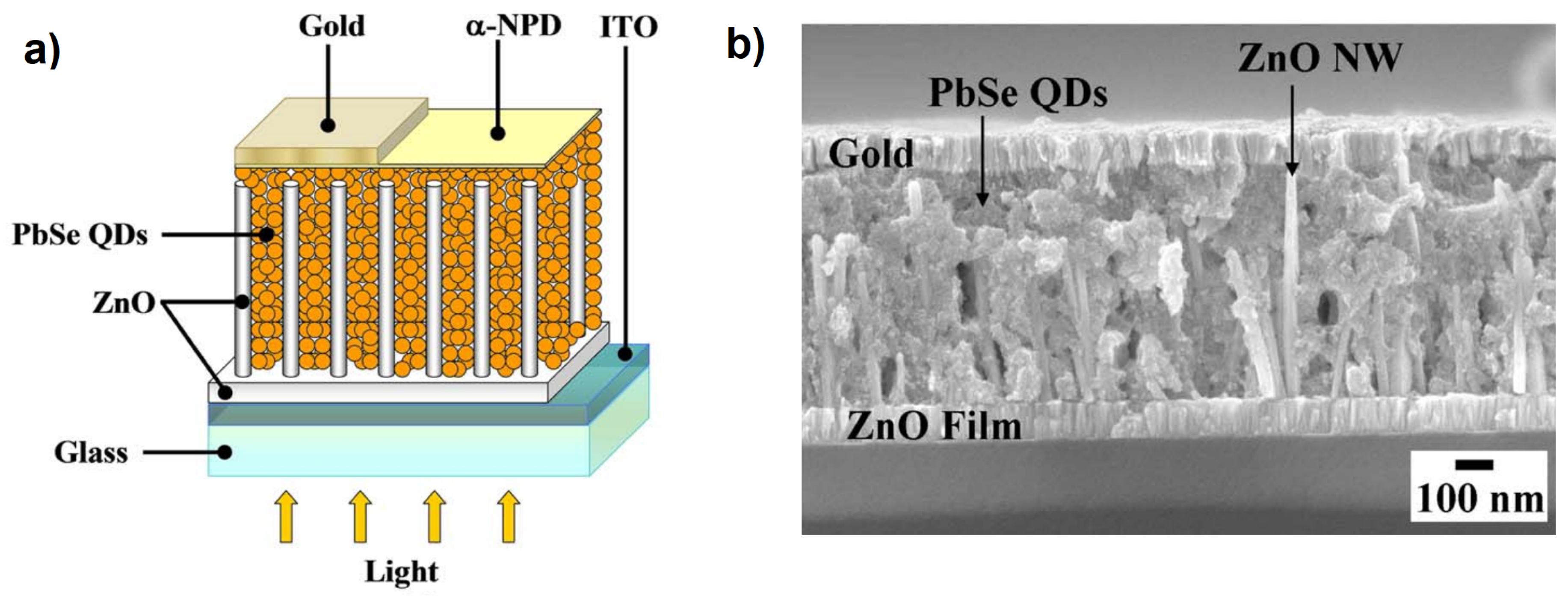

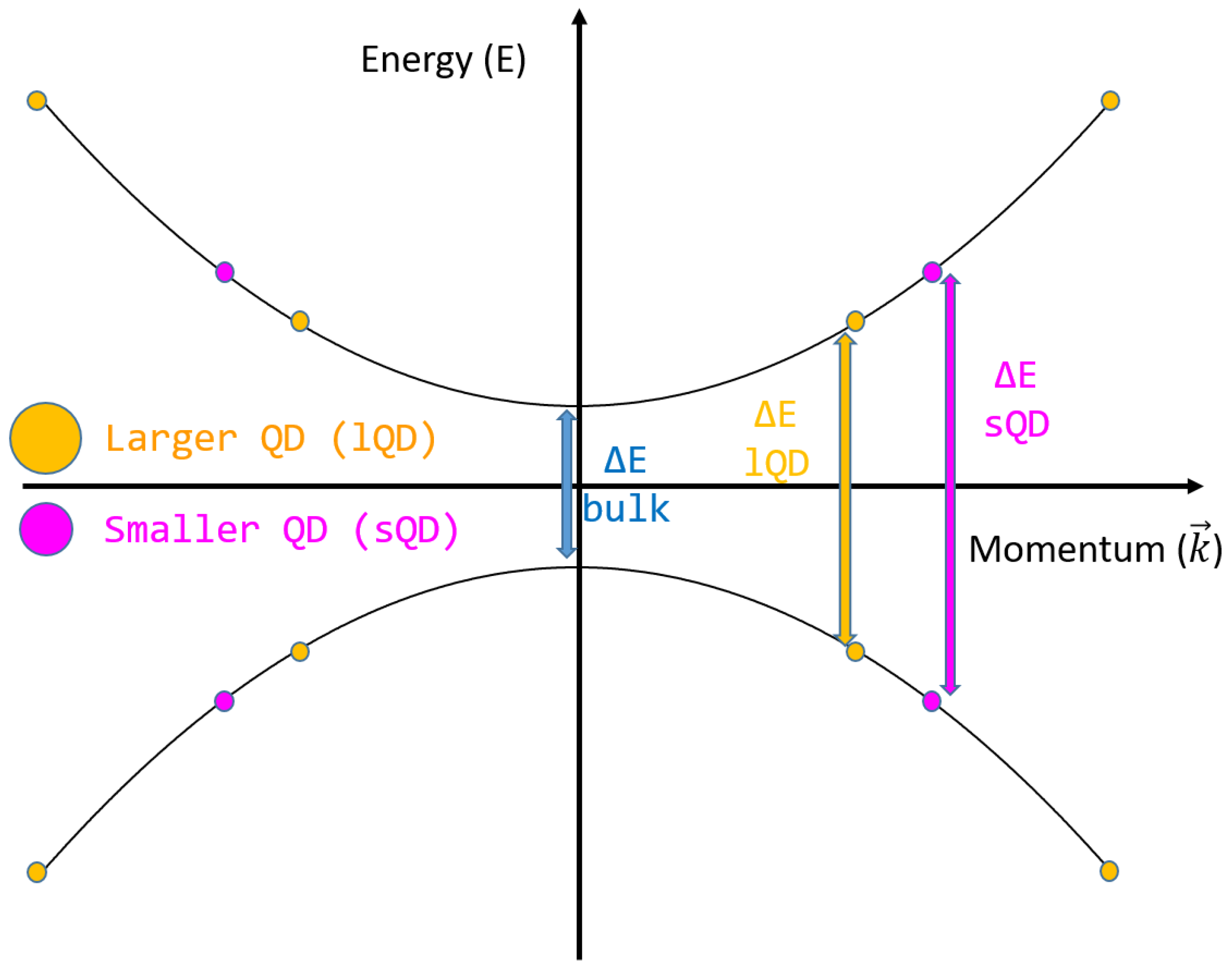
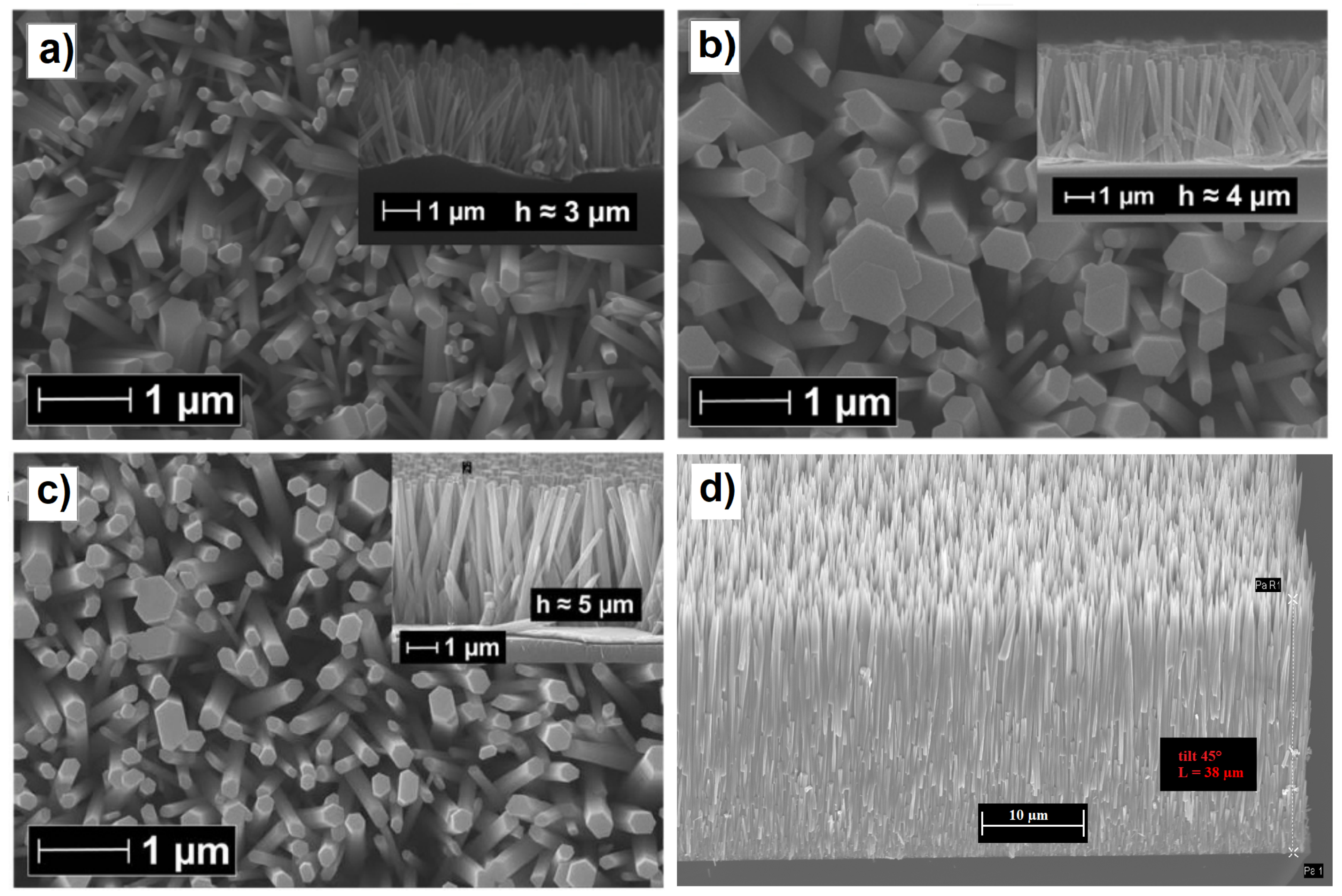
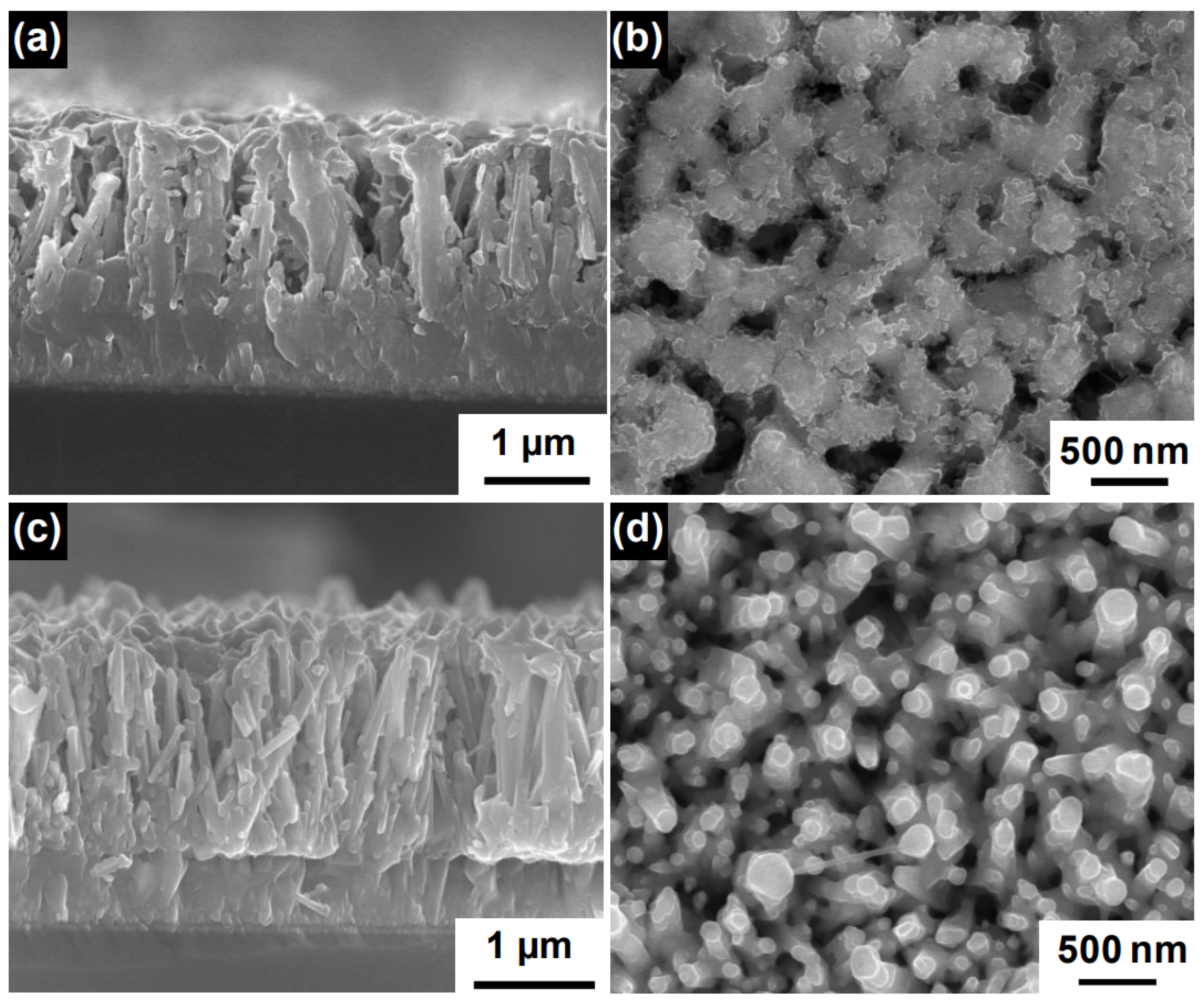

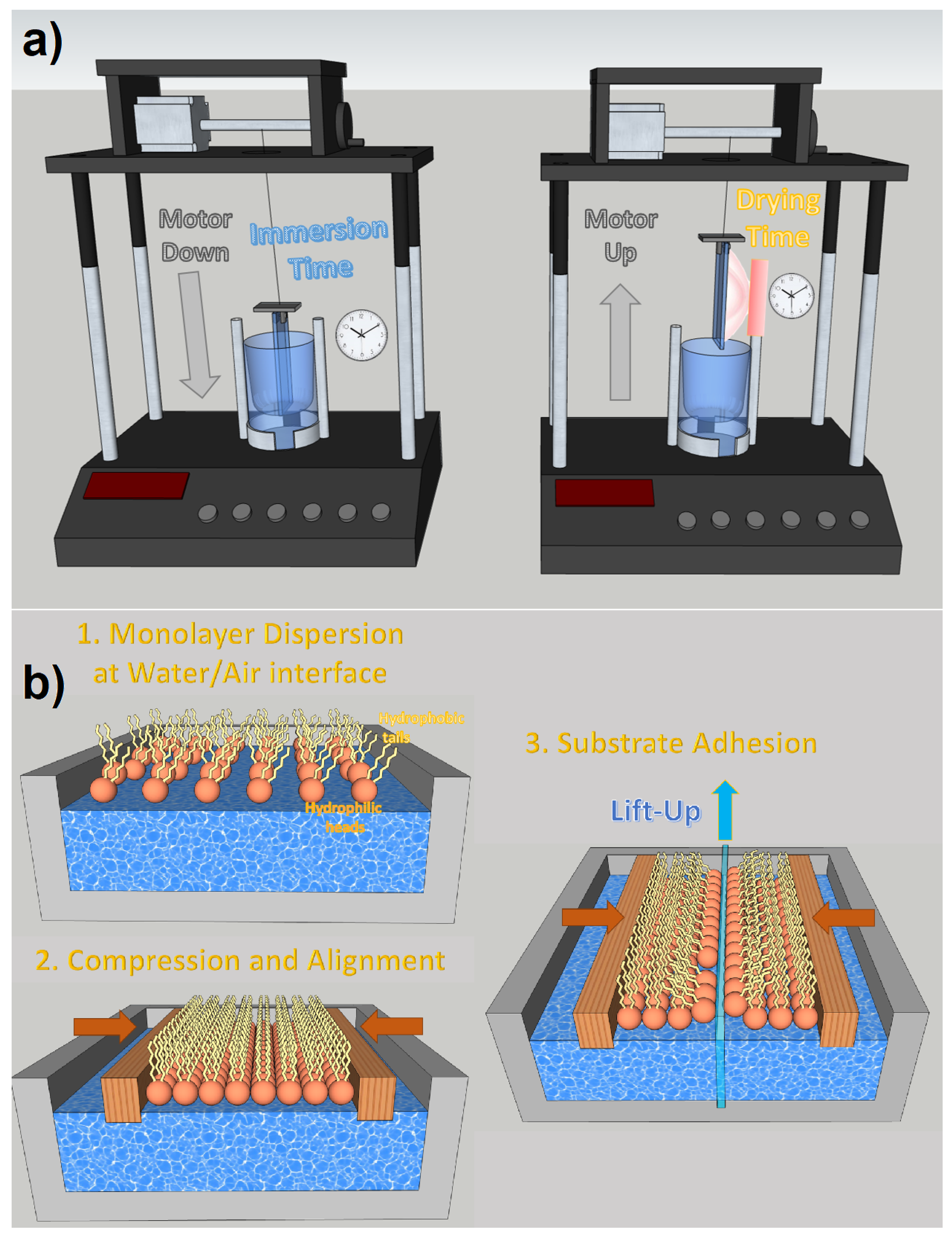



| Property | ZnO | TiO | SnO |
|---|---|---|---|
| Lattice | Wurtzite | Rutile, Atanase | Rutile |
| Electron mobility * cm/(Vs) | 100–150 [53] | 0.001 [54] | >200 [19] |
| Band gap [55] | 3.3 eV | 3.2 eV | 3.5 eV |
| Work function [56] | 6.4 eV | 6.4 eV | 6.1 eV |
| Substrate | Light Absorber | Reference | J | V | PCE |
|---|---|---|---|---|---|
| Nanostructures/Passivation | Ligand/Shell | Year | [mA/cm] | [V] | [%] |
| Glass/ITO | CuSbS QDs | [98] | 5.9 | 0.49 | 1.61 |
| ZnO NWs | [2016] | ||||
| Glass/FTO | CdSe/CdS QDs | [99] | 15.6 | 0.74 | 5.92 |
| ZnO NWs | TiO/Ag NPs | [2016] | |||
| Glass/ITO | PbS QDs | [100] | 29.4 | 0.57 | 9.6 |
| ZnO NWs | TBAI * | [2016] | |||
| Mesoporous | Zn–Cu–In–Se | [101] | 24.95 | 0.62 | 9 |
| TiO NWS | [2017] | ||||
| FTO | Mn:InS | [102] | 26.5 | 0.644 | 8 |
| TiO nanoparticles | CuInS | [2018] | |||
| Glass/FTO | PbS QDs | [103] | 23.2 | 0.598 | 7.49 |
| ZnO NWS/ZnSnO | [2019] | ||||
| Glass/ITO | PbS QDs | [104] | 27.9 | 0.53 | 9.92 |
| ZnO NWs/4-aminobenzoic acid | TBAI * | [2019] | |||
| Glass/ITO | PbS + CdSe/ZnS QDs | [105] | 32.8 | 0.592 | 10.6 |
| ZnO NWs | TBAI * | [2019] | |||
| Glass/ITO | PbS QDs | [106] | 31.1 | 0.61 | 10.8 |
| ZnO NWs/hydrogen plasma | TBAI * | [2020] | |||
| Glass/FTO | Zn–Cu–In–Se | [107] | 24.2 | 0.79 | 13.5 |
| TiO nanoparticles | ZnSe | [2020] | |||
| Glass/FTO | Zn–Cu–In–S–Se | [108] | 26.5 | 0.8 | 15.3 |
| TiO nanoparticles | ZnSe | [2021] |
| Substrate, | Reference | J | V | PCE |
|---|---|---|---|---|
| Nanostructures/Passivation | Year | [mA/cm] | [V] | [%] |
| Glass/ITO, ZnO NWs | [2015], [112] | 21.7 | 0.97 | 16.2 |
| Glass/AZO, ZnO nanocones/ZnSnO | [2019], [113] | 23.2 | 1.07 | 18.3 |
| Glass/FTO, ZnO nws/ZnSe | [2019], [109] | 18.64 | 0.835 | 8.2 |
| Flexible PET/ITO, ZnO nws/ZnS | [2021], [114] | 24.4 | 0.97 | 14.68 * |
| Glass/FTO, ZnO nws/ZnS | [2021], [115] | 23.48 | 1.1 | 19.9 |
Disclaimer/Publisher’s Note: The statements, opinions and data contained in all publications are solely those of the individual author(s) and contributor(s) and not of MDPI and/or the editor(s). MDPI and/or the editor(s) disclaim responsibility for any injury to people or property resulting from any ideas, methods, instructions or products referred to in the content. |
© 2023 by the authors. Licensee MDPI, Basel, Switzerland. This article is an open access article distributed under the terms and conditions of the Creative Commons Attribution (CC BY) license (https://creativecommons.org/licenses/by/4.0/).
Share and Cite
Prestopino, G.; Orsini, A.; Barettin, D.; Arrabito, G.; Pignataro, B.; Medaglia, P.G. Vertically Aligned Nanowires and Quantum Dots: Promises and Results in Light Energy Harvesting. Materials 2023, 16, 4297. https://doi.org/10.3390/ma16124297
Prestopino G, Orsini A, Barettin D, Arrabito G, Pignataro B, Medaglia PG. Vertically Aligned Nanowires and Quantum Dots: Promises and Results in Light Energy Harvesting. Materials. 2023; 16(12):4297. https://doi.org/10.3390/ma16124297
Chicago/Turabian StylePrestopino, Giuseppe, Andrea Orsini, Daniele Barettin, Giuseppe Arrabito, Bruno Pignataro, and Pier Gianni Medaglia. 2023. "Vertically Aligned Nanowires and Quantum Dots: Promises and Results in Light Energy Harvesting" Materials 16, no. 12: 4297. https://doi.org/10.3390/ma16124297










